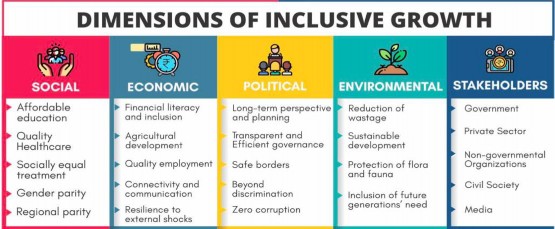2. Dimensions of Inclusive Growth

3. Why is Inclusive Growth Needed?
♤ Increasing Global Inequality: Inequalities in the world has increased in the last three decades. Also there has been profound changes in the labor market due to technological changes, increased migration, ageing societies and shifting employment pattern. The direction of these changes have unfortunately often drifted the economies away from inclusiveness and social justice.

♤ Changing labour market: The new ‘disruptive’ technology and new global digital infrastructure has changed the face of ‘work’. Many existing jobs are vanishing and new ones are emerging. According to a report by Raghuram Rajan (2018), there is need to move from routine and less productive work like agriculture and low productive industry and services and seize the opportunity in other spaces in areas of exports, tech start-ups in India.
♤ Inequal Women Participation: Inequality in participation of women in the workforce is another issue. According to McKinsey Report 2015 , if women play identical role in the labour market $28 trillion, or 26 per cent, could be added to global annual GDP by 2025. The report said that in Indian case, there would be 60 per cent increase in GDP by 2025.
♤ Lack of inclusive growth: Economic growth has not automatically resulted in inclusive growth. According to Joseph Stiglitz, despite long period of high growth, 14.5 percent of the population in the World in 2011 still faced poverty. It is a testimony that growth has not been all inclusive and policies have to go beyond just promoting growth.
Success of a future inclusive growth agenda would depend investment in employment intensive sectors and ensuring equal participation across various regions, gender and social groups. For India, investment on universal quality education and universal quality health care hold the key for inclusive growth.
